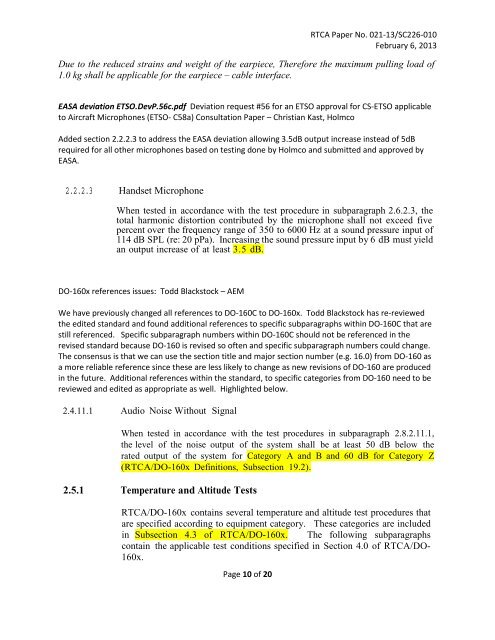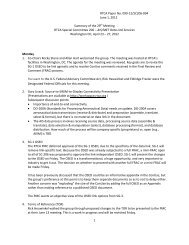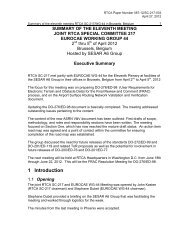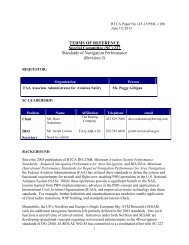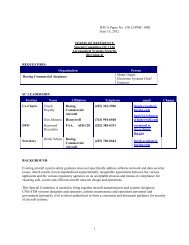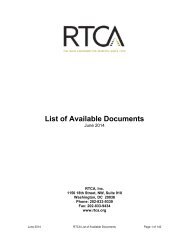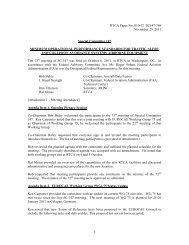SC-226 MEETING MINUTES Working Group JANUARY 14 ... - RTCA
SC-226 MEETING MINUTES Working Group JANUARY 14 ... - RTCA
SC-226 MEETING MINUTES Working Group JANUARY 14 ... - RTCA
You also want an ePaper? Increase the reach of your titles
YUMPU automatically turns print PDFs into web optimized ePapers that Google loves.
<strong>RTCA</strong> Paper No. 021-13/<strong>SC</strong><strong>226</strong>-010<br />
February 6, 2013<br />
Due to the reduced strains and weight of the earpiece, Therefore the maximum pulling load of<br />
1.0 kg shall be applicable for the earpiece – cable interface.<br />
EASA deviation ETSO.DevP.56c.pdf Deviation request #56 for an ETSO approval for CS-ETSO applicable<br />
to Aircraft Microphones (ETSO- C58a) Consultation Paper – Christian Kast, Holmco<br />
Added section 2.2.2.3 to address the EASA deviation allowing 3.5dB output increase instead of 5dB<br />
required for all other microphones based on testing done by Holmco and submitted and approved by<br />
EASA.<br />
2.2.2.3 Handset Microphone<br />
When tested in accordance with the test procedure in subparagraph 2.6.2.3, the<br />
total harmonic distortion contributed by the microphone shall not exceed five<br />
percent over the frequency range of 350 to 6000 Hz at a sound pressure input of<br />
1<strong>14</strong> dB SPL (re: 20 pPa). Increasing the sound pressure input by 6 dB must yield<br />
an output increase of at least 3.5 dB.<br />
DO-160x references issues: Todd Blackstock – AEM<br />
We have previously changed all references to DO-160C to DO-160x. Todd Blackstock has re-reviewed<br />
the edited standard and found additional references to specific subparagraphs within DO-160C that are<br />
still referenced. Specific subparagraph numbers within DO-160C should not be referenced in the<br />
revised standard because DO-160 is revised so often and specific subparagraph numbers could change.<br />
The consensus is that we can use the section title and major section number (e.g. 16.0) from DO-160 as<br />
a more reliable reference since these are less likely to change as new revisions of DO-160 are produced<br />
in the future. Additional references within the standard, to specific categories from DO-160 need to be<br />
reviewed and edited as appropriate as well. Highlighted below.<br />
2.4.11.1 Audio Noise Without Signal<br />
When tested in accordance with the test procedures in subparagraph 2.8.2.11.1,<br />
the level of the noise output of the system shall be at least 50 dB below the<br />
rated output of the system for Category A and B and 60 dB for Category Z<br />
(<strong>RTCA</strong>/DO-160x Definitions, Subsection 19.2).<br />
2.5.1 Temperature and Altitude Tests<br />
<strong>RTCA</strong>/DO-160x contains several temperature and altitude test procedures that<br />
are specified according to equipment category. These categories are included<br />
in Subsection 4.3 of <strong>RTCA</strong>/DO-160x. The following subparagraphs<br />
contain the applicable test conditions specified in Section 4.0 of <strong>RTCA</strong>/DO-<br />
160x.<br />
Page 10 of 20


